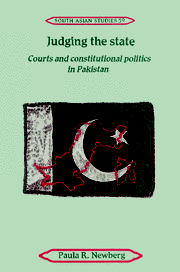Book contents
- Frontmatter
- Contents
- Preface
- Introduction
- 1 Structuring the state
- 2 Constituting the state (1947–1958)
- 3 Confining courts and constitutions (1958–1969)
- 4 Seeking justice (1969–1972)
- 5 Testing courts and constitutionalism (1972–1977)
- 6 Silencing courts, muting justice (1977–1988)
- 7 Reviving judicial powers (1988–1993)
- 8 Judging the state
- Table of cases
- Bibliography
- Index
- Cambridge South Asian Studies
7 - Reviving judicial powers (1988–1993)
Published online by Cambridge University Press: 06 January 2010
- Frontmatter
- Contents
- Preface
- Introduction
- 1 Structuring the state
- 2 Constituting the state (1947–1958)
- 3 Confining courts and constitutions (1958–1969)
- 4 Seeking justice (1969–1972)
- 5 Testing courts and constitutionalism (1972–1977)
- 6 Silencing courts, muting justice (1977–1988)
- 7 Reviving judicial powers (1988–1993)
- 8 Judging the state
- Table of cases
- Bibliography
- Index
- Cambridge South Asian Studies
Summary
What parents sowed, the children reap.
Who's the benefactor? Who the thief?
When the corn came in, the knives came out;
Brother fought brother for every sheaf.
One sinned, another bears the grief.
What parents sowed, the children reap.
Bulleh Shah, “Heritage.”Courts do not exist in isolation. Judges are part of the society in which we all live.
Justice Dorab PatelFrom the time that martial law was formally lifted at the end of 1985, the transition to mixed civil–military governance was complicated by constitutional structures that General Zia had hoped would simplify his post-martial law tenure. He tried to achieve a balance between military rule and limited civilian participation in government, relying on constitutional amendments, implementing laws and selected military regulations rather than the full force of martial law. Although General Zia absorbed some lessons of past transitions – including providing immunity from prosecution for government officials once the protections of military rule was gone – establishing control over the pace and content of change was virtually impossible. Petitioners and courts alike soon realized that these same laws provided the means, although occasionally tortuous, to unravel the web of restrictions covered by the eighth amendment. The courts therefore became vehicles for altering the relationship between state and citizen under a constitutional order otherwise inaccessible to challenge; individuals sought relief from the courts when none was available elsewhere.
- Type
- Chapter
- Information
- Judging the StateCourts and Constitutional Politics in Pakistan, pp. 200 - 232Publisher: Cambridge University PressPrint publication year: 1995

